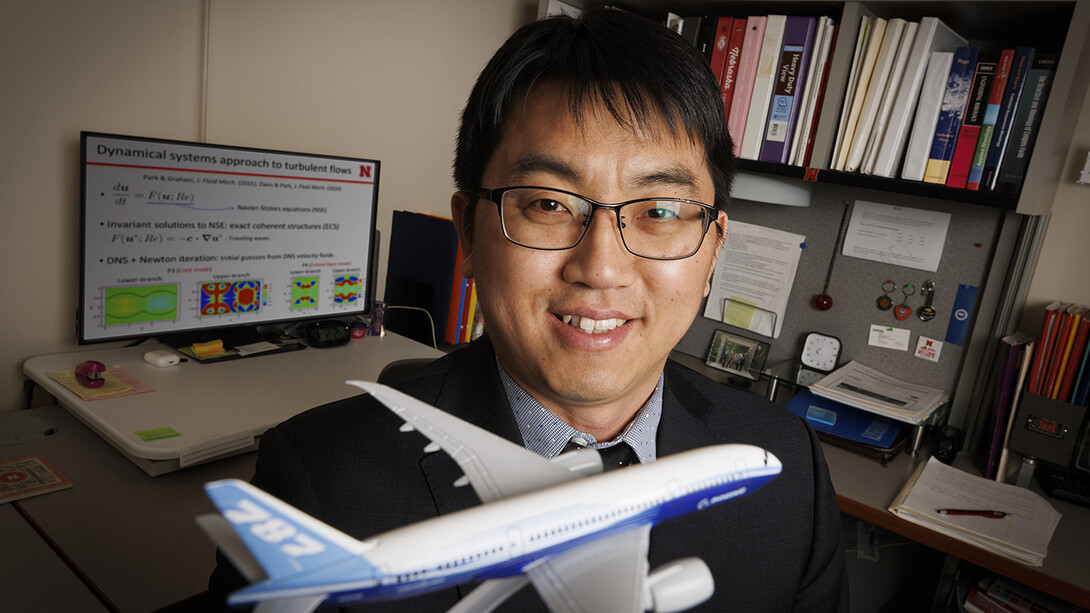
In trying to solve a mysterious problem of physics, University of Nebraska–Lincoln engineer Jae Sung Park expects to encounter more than a fair share of turbulence along the way.
Having earned a five-year, $508,780 Faculty Early Career Development Program award from the National Science Foundation, Park is aiming to solve one of the great problems in science — discovering patterns or orders in turbulent flows of gases and liquids, and then developing methods of exploiting those orders to mitigate their impact on the world.
“We are trying to understand the factors that lead to turbulence, step by step, mostly taking baby steps,” said Park, assistant professor of mechanical and materials engineering. “Even though we have supercomputers and can conduct big, complex experiments, it is still hard to predict turbulence.
“Since turbulence is omnipresent, if we can more accurately predict how, when and where turbulence will happen, its impact would be enormous. For example, we can save billions of dollars in energy usage and possibly save lives by predicting cardiovascular events (such as strokes and heart attacks) or major weather events (such as tornadoes or hurricanes).”
Park’s project, titled “Unraveling Predictive and Multiscale Dynamics in Turbulence for Flow Control,” aims to unravel the intricacies of turbulence by starting with simple understandings about its nature that could help remove the chaos in turbulence.
Turbulence is often seen as unpredictable. This is largely because turbulence occurs as fluid layers mix, leading to the formation of various sizes of swirls, or vortices, that interact with each other in a complex way. But Park is looking to apply the discovery of both predictive and multiscale dynamics in turbulent flows to develop a more rigorous strategy for steering turbulence toward desirable states by predicting and controlling targeted vortices.
“In general, even though turbulence looks chaotic, there are certain patterns. It’s not just random,” Park said. “You have to look closely to see those patterns.”
To do this, Park aims to identify certain vortices that give certain patterns around them. These patterns help to predict changes in turbulence, such as the speed and pressure of the flow or its direction. Eventually, researchers could predict where and how various vortices interact, leading to a better understanding of when and how a new vortex and patterns will occur.
Park’s team, which will include a graduate student and up to two undergraduates, will use mathematical tools and create computer models to better predict the probabilities of where and when turbulence creates a new vortex within the flow. Being able to predict turbulence would allow for the development of procedures and products that can lessen its impact, Park said.
From a flow-control perspective, even a slight decrease in turbulence could have a significant impact on the world’s energy consumption.
“For example, most of the energies we use for airplanes, even reducing turbulence by 5% might be enough to reduce (fuel) consumption by up to half,” Park said. “And if we can reduce air turbulence by even 1%, it’s been said we could save about $2 billion per year in airplane fuel consumption.”
Part of the work done through this grant will include collaboration with the university’s Food Processing Center on Nebraska Innovation Campus, looking at ways a possible reduction in turbulence in piping systems can lead to cost savings in food industries. The award will also provide funding for Park and his team’s outreach projects, which will teach K-12 students about fluid dynamics in sports such as basketball and swimming.
“This is a hard, hard problem, as noted by Richard Feynman (Nobel Prize laureate in physics), (who said) that turbulence is the last great unsolved problem of classical physics,” Park said. “I want to start right so we can build a foundation. Hopefully we can find a solution and also inspire young students to take this in another direction in the future and make things not so chaotic.”








